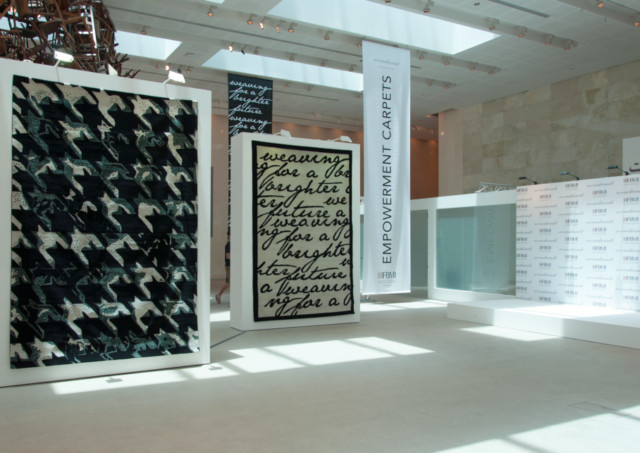
Design plays a big role in making our world prettier. But the higher powers vested in design go beyond the latest Chanel Cruise Collection and the most devastatingly designed Bugatti.
French designer and social activist Florie Salnot’s shortlisted entry for the 2014 V&A Jameel Prize, Plastic Gold, might not have won the coveted award but it puts the plight of the displaced people of the Western Sahara back in the world’s spotlight almost 35 years after half of the local population (the Saharawis) was forced to flee to SW Algeria, where they were allowed to establish the Saharawi state-in-exile in refugee camps.
Winning the Jameel would have been nice, Salnot told me later. But according to her, the recognition gave the Sahrawis confidence and a recognition to their cause: “And when all you have left is your arts and craft, that is a big deal”.
Salnot is not the only one harnessing the real power of design. Indian fashion design and conservator Rahul Jain has been working hard at reviving design vocabularies in his home country, just as Mexico City based design house Fabrica Mexico reinterprets traditional crafts and iconography for 2015 and beyond. What these people are doing goes beyond creating beautiful, expensive pieces of self-indulgent works (and living in Dubai, we know how many of those exist). They are holding the hands of people and crafts lost in the time, ravaged by the industrial revolution — as in the Sahrawis case, by war — and are giving them their identity again.
Closer home, Her Highness Sheikha Fatema Bint Mohammed Bin Zayed Al Nahyan Initiative (FBMI) has been working closely with Tanweer Investments to bring about change in Afghanistan from the grass roots. Shaken by the harsh realities of life in the country — child mortality above 25 per cent, an average lifespan of 44 years, and 42 per cent of the population living on less than $1 (Dh3.67) per day — she is going about bringing change through carpet making — a skill Afghani women already possess. Apart from providing employment to them, the initiative also offers social, educational and healthcare support.
When the Chairman of Tanweel Investments, Dawood Jabarkhyl returned to Afghanistan in 2001, he made it his mission to create dignified employment in the country. “In 2004, I began planning the best way to employ as many Afghans as possible — mainly women — but ethically, and more importantly, sustainably,” says the founder of FBMI. “I looked to the country’s largest exports good, the handmade carpets as a starting point.” He found a dedicated ally in the Sheikha, who was also very keen to help the Afghan women, and together they launched the FBMI.
The FBMI’s latest project, in collaboration with award-winning New York based designer Norma Kamali, was unveiled earlier this week. Called Weaving for a Brighter Future, the “empowerment carpets” — a collection of 12 handmade black and white designs — intend to draw focus on the plight of Afghan women and give them an opportunity to work.
“As the project supervisor, taking Norma’s designs to Afghanistan and overlooking the year long production, I found the Afghani women to be keen learners,” says Sadaf Safi, the manager of FBMI. “Their desire to excel themselves out of their present unfortunate situation was apparent in their attitude towards the project, but mostly I could see it in their eyes.”
“It was important that we collaborate with a known name so the issue can be better highlighted, but we also wanted the person to be one who is deeply involved in their own communities so they understand our end goals better,” says Jabarkhyl.
Kamali was chosen for this project because her designs stand out. This is exactly what the project needed — a strong, defiant voice that is audible in the 12 pieces that stand miles apart from the traditional Afghani carpet designs. “It was important that the collection was not an interpretation of the old designs and palettes,” says Safi. “The traditional techniques and handicrafts are still very much on show, but the designs are for today’s world and spaces. More importantly, they showcase a community and a country moving into the future.”
The response the empowerment carpets has received is a show of faith in the Afghans, says Jabarkhyl. “It shows they are talented, dedicated and can flourish in situations that provide them dignified employment.”
— Pratyush Sarup edits design blog Designcarrot.co









